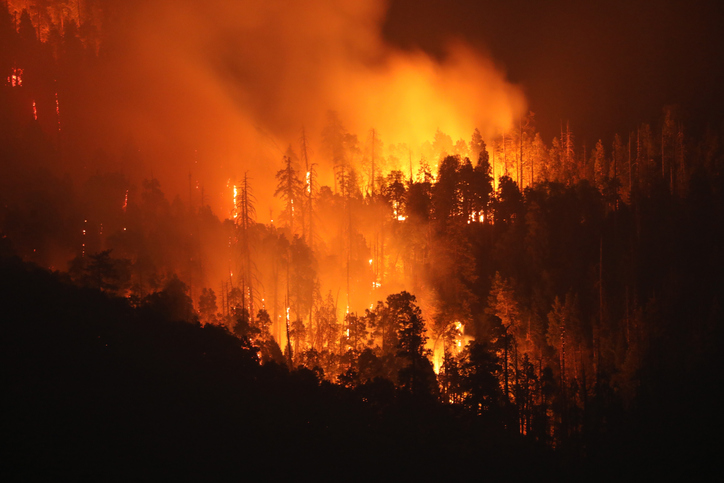It’s no secret that we’re experiencing a global uptick in extreme weather and natural disasters as a direct result of climate change. In fact, a study supported by the National Oceanic and Atmospheric Administration (NOAA) found climate change to be the main driver of the increase in fire weather in the western U.S., pointing to increased heat, extended droughts, and a thirsty atmosphere as key factors. As of mid-May, the National Interagency Fire Center has tracked over 12,600 wildfires that have burned an astounding 1.8 million+ acres so far this year. As climate change continues to elevate the risk of wildfires, these events are becoming more frequent, destructive, and difficult to fight.

With these facts in mind, we must accept that future wildfires are inevitable. We also can’t rely on fire departments alone to have the staffing, equipment, and resources to protect all people and properties in harm’s way. Instead, it’s becoming more of a shared responsibility for everyone, including residents, business owners, contractors, and facilities managers, to mitigate wildfire threats in this era of climate change. This is especially true for those living or working in wildfire hotspots.
Not Every Wildfire Is a Disaster
As easy as it is to categorize every wildfire as a natural disaster, this isn’t always the case. The term wildfire doesn’t necessarily mean the fire is out of control; it simply means it stems from an unplanned ignition source, whether natural or caused by humans. These fires happen worldwide in underdeveloped and uninhibited land like forests, grasslands, brushlands, and other ecosystems. Their tie to climate change arises from the fact that atmospheric factors like temperature and humidity, along with others like topography and fuel sources, greatly affect how a wildfire burns and potentially spreads.
In some cases, wildfires can help revitalize ecosystems by clearing brush or debris, returning nutrients to soil, or killing problematic insects. To reap these benefits, “controlled burns” have been used for hundreds of years to make wildlands healthier. However, uncontrolled burns can quickly become dangerous, especially when they become uncontainable or encroach on urban areas.
As the number of wildfires in this second category rises, proactive measures are necessary to protect people and structures. For example, residents can band together and follow the guidelines put forth in the Firewise USA program to reduce the risk of wildfire destruction in their neighborhoods or communities. At a higher level, governments can support the five tenets laid out in the National Fire Protection Association’s (NFPA) Outthink Wildfire policy initiative to solve wildfire problems and drive change.
Steps to Protect Facilities
Facilities managers can also promote the resiliency of their buildings in the face of a natural disaster. As a first step, they should ensure their facilities meet necessary building, fire, and life safety codes and standards. For example, NFPA 1140, Standard for Wildland Fire Protection, is a combination of previous NFPA standards representing the most effective and efficient means to reduce wildfire risks to people and properties. For new builds, codes and standards like this guide developers and contractors to construct buildings that are safer and healthier by design. But they also help address hazards and vulnerabilities in existing buildings and improve overall safety. With digital tools like NFPA LiNK, workers can instantly access the most up-to-date NFPA codes and standards on any device, making compliance easier.
Secondly, facilities managers should seek out contractors who have the proper education and training on mitigating wildfire risks, or who are willing to consider these programs as part of their ongoing professional development. For instance, NFPA offers a wildfire mitigation specialist certification for those looking to gain knowledge about hazard mitigation, planning and preparedness, public education, and related fire science concepts. The more training and certifications that facilities managers and the contractors they employ have under their belt, the better qualified they will be to cover all the bases for buildings that stand the test of time.
Last, but certainly not least, facilities managers should prioritize routine inspection, testing, and maintenance (ITM) of their buildings and surrounding landscape. Having a solid ITM plan and schedule goes a long way toward identifying and fixing structural vulnerabilities or fire hazards, such as a patchy roof, windows that don’t shut, or flammable debris or objects in gutters or elsewhere on the property. ITM also helps ensure fire and life safety systems—such as fire alarms, sprinklers, and clearly marked exits—are operating correctly, while allowing for quicker identification and resolution of issues.
It’s equally important for building staff to be trained in how to use these systems, as well as in emergency response protocols. For example, what are the evacuation routes both out of the building and away from the premises? Who will take charge? Is there a direct line of communication with the fire department? Facilities managers who consistently revisit their disaster preparedness plans have a better shot at minimizing the impact of wildfires and returning to normal operations more seamlessly.
Climate change will only continue to influence our built environment over time. This means that a new, more proactive approach to fire and life safety is needed to protect people and structures from potentially devastating events like wildfires. While no one is exempt from doing their part to prevent harm from natural disasters, facilities managers and skilled trades workers have a particularly exciting opportunity to ease losses and disaster-proof their buildings.
Michele Steinberg is Wildfire Division Director at the National Fire Protection Association (NFPA).
ALSO READ: Combat Wildfire and Infection Hazards with Good Indoor Air Quality
